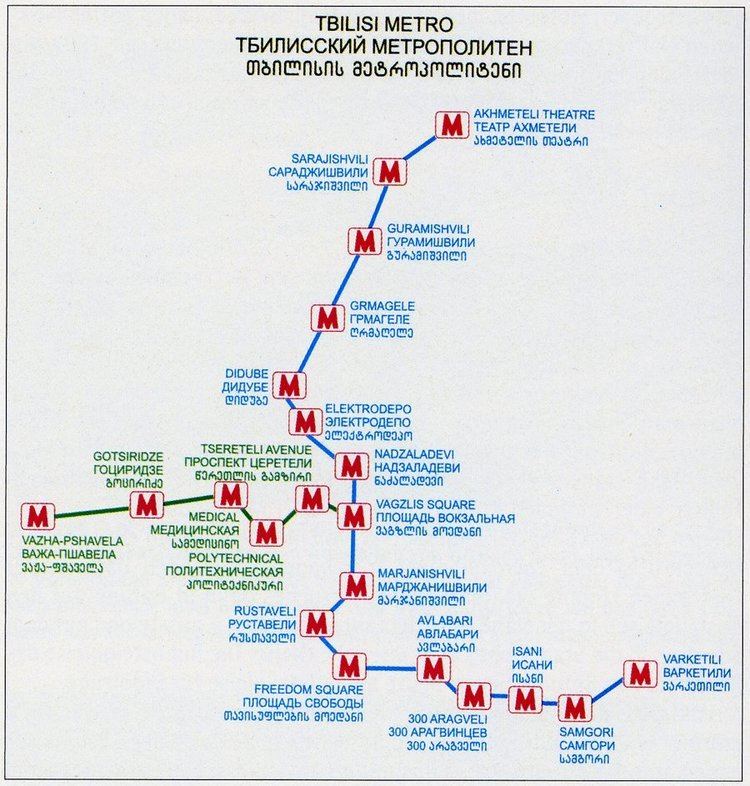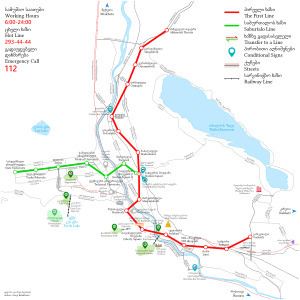Native name თბილისის მეტრო Annual ridership 96.26 million (2013) Opened 11 January 1966 Began operation December 11, 1966 Number of vehicles 170 | Train length 3–4 cars Number of stations 22 Number of lines 2 Transit type Rapid transit | |
 | ||
Operator(s) Tbilisi Transport Company | ||
Tbilisi georgia metro station vazha pshavela tbilisi metro
The Tbilisi Metro (Georgian: თბილისის მეტროპოლიტენი) is a rapid transit metro system in Tbilisi, Georgia. Opened on 11 December 1966, it was the fourth Metro system in the former Soviet Union. Like most ex-Soviet Metros, most of the stations are very deep and vividly decorated
Contents
- Tbilisi georgia metro station vazha pshavela tbilisi metro
- Tbilisi metro rustaveli station gldani varketili line iii
- Network
- Operation
- Fares
- History
- Future
- References

The Tbilisi Metro comprises two lines, 27.1 kilometres (16.8 mi) in total length, serving 22 stations. In 2012, the Metro transported 93.9 million passengers, a significant increase on the 85.6 million passengers served in 2011. In 2013, the Metro transported 96.26 million passengers. It is operated by the Tbilisi Transport Company, which began operation the same year as the Tbilisi Metro, in 1966.

Tbilisi metro rustaveli station gldani varketili line iii
Network
Operation

As of 2012, the system consists of two lines, serving 22 stations, operating on 27.1 kilometres (16.8 mi) of route and 62.5 kilometres (38.8 mi) of track. Of the 22 stations, 20 stations are below ground and two are surface level. Of the subterranean stations, 16 are deep level and 4 shallow. The former comprise 6 pylon stations, 5 column and 5 single vaults (built to the Leningrad Technology). The shallow stations consist of three pillar-trispans and one single vault (Kharkov Technology). Due to Tbilisi's uneven landscape, the Metro, particularly the Gldani-Varketili line, has one surface-level section.

An estimated total of 105.6 million people used the Metro annually as at 2005, tough the actual figure by 2012 was closer to 94 million. Carrying them are a fleet of 170 Soviet-built rail cars, consisting of the 81–717/714 and ЕЖ3 models, which operate from two depots. Station platforms are built to accommodate five-carriage trains, though four- and three-car trains respectively operate on Line 1 and Line 2

Trains run from a little before 6:00 am (exact times vary depending on the station) until midnight, with intervals ranging between 2 1/2 minutes at peak times to 12 minutes later in the night. Train speeds are 60–90 kilometres per hour, while the average trip speed is slightly over 33 kilometres.
Fares
The Tbilisi Metro uses a flat-fare system of 50 tetri per journey. Tokens are no longer in use, and riders must purchase for ₾2 a Metromoney Card (a stored value card available at metro stations), onto which they can add fares. The card allows riders to re-enter the system for 90 minutes upon leaving it, however, at no charge.
History
Tbilisi (officially known as Tiflis until 1936), capital of Georgia, was always considered to be the fourth most important city of the Soviet Union, particularly in view of its political position as being the capital of the republic (Georgian SSR). The city grew quite rapidly during the 19th and 20th centuries, and apart from being a cultural and political centre, it was also an important transport hub in Transcaucasia and an industrial centre as well. All this amounted to the need for a rapid transit Metro system.
Construction began in 1952. Tbilisi was the one of the only cities of the former USSR where the construction of the Metro system started before the resident population exceeded one million. A population over one million was one of the main criteria for building a metro system in the Soviet cities. On 11 January 1966, the Tbilisi Metro was opened: it was the first and only Metro system in Georgia and the fourth one in the former Soviet Union (after Moscow, Saint Petersburg, and Kiev), when the first six stations were opened. Since then, the system has steadily grown to a two line, 22 station network.
During the 1990s, most of the Soviet-era station names were changed, although financial difficulties after the breakup of the Soviet Union hit the Metro particularly hard in its infrastructure, operations and extensions. In the early-mid 1990s the Tbilisi metro was usually not working due to the lack of electricity. Until recently, the Metro had been underfunded and operated in severe difficulties due to poor electrical supply. It had also become infamous for widespread petty crime, like pickpocketing and mugging. In addition, there have been several incidents at metro stations in recent years. On October 9, 1997, a former policeman blew himself up at Didube station. On February 14, 2000, a teenager threw a homemade hand grenade into a metro station, injuring several people. In March 2004, several people were poisoned by an unidentified gas while using the Metro.
However, the crime has reduced as a result of security and administration reforms in the system from 2004 to 2005. Other services have also significantly improved.
Currently, the Tbilisi Metro system is undergoing a major rehabilitation effort, including the reconstruction of the stations as well as modernization of trains and other facilities. The city's 2006 budget allocated 16 million lari for this project. President of Georgia, Mikhail Saakashvili, promised to make the Metro a most prestigious public transport system, and charged Director General of Tbilisi Metro, Zurab Kikalishvili, in late 2005, to bring the metro up to European standards by 2007. In subsequent years, however, the upgrade process has slowed significantly, and as of July 2010, the Tbilisi metro rail was still far from its target standard.
Future
The system has also an advanced extension plan, with a third line, amongst other locations, encompass the district of Vake. Forming a typical Soviet triangle with three-line six radii layout intersecting in the city centre. However, most of the construction sites remain frozen, some dating to Soviet times.
In January 2012 construction was scheduled to start on a frozen extension of the Saburtalo Line from the Vazha-Pshavela station to the new Universiteti station, of which 80% of the work was completed during the Soviet era. Financed by the Asian Development Bank, construction was restarted in July 2015 and the station is scheduled to open in May 2017.
There are also plans to construct a tram network in Tbilisi.
